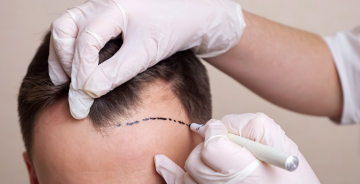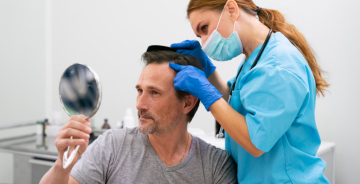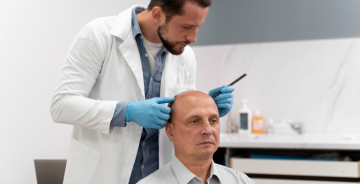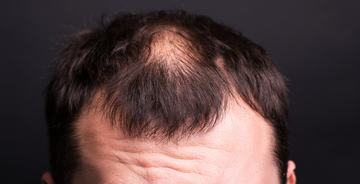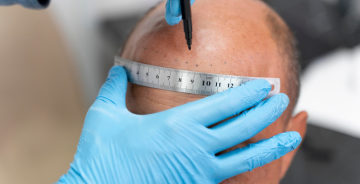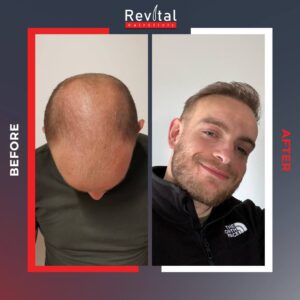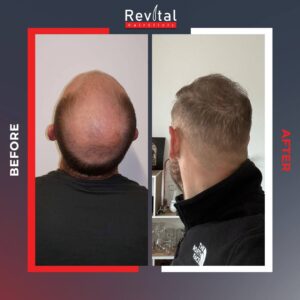Category Blog
30 Sep
Techniques Used
Techniques Used in Hair, Beard, and Eyebrow Transplantation Hair restoration procedures have evolved significantly over the last two decades. Today’s advanced transplant techniques allow for natural-looking, permanent results with minimal discomfort and downtime. Whether it’s scalp hair, beard, or eyebrow transplantation, the technique used plays a crucial role in the outcome. In this article, we’ll break down the most commonly used hair transplant techniques, how they work, and which situations they are best suited for. 1. FUE (Follicular Unit Extraction) – The Gold Standard FUE is currently the most popular and advanced hair transplant technique used worldwide. How It Works: Individual hair follicles are extracted one by one from the donor area (typically the back or sides of the scalp). These follicles are then implanted into the recipient area (scalp, beard, or eyebrows). The process is minimally invasive and leaves no linear scar. Advantages: Virtually scar-free Quick recovery (most patients return to normal activities within days) Ideal for beard and eyebrow transplantation due to precision Natural-looking results when done by experienced professionals Ideal For: Patients who want to wear their hair short Those needing detailed work (eyebrows, beard lines, temple areas) 2. DHI (Direct Hair Implantation) – Precision & Control DHI is a modified form of FUE, where the extracted follicles are implanted directly using a special implanter pen (Choi Pen). How It Works: Follicles are harvested using FUE. Instead of creating recipient incisions first, follicles are inserted directly with the implanter pen in one step. Advantages: More precise control over depth, angle, and direction Potentially higher survival rate of grafts Less bleeding and trauma Great for high-density and refined areas, such as eyebrows or beard outlines Ideal For: Patients looking for a very natural, dense finish Eyebrow and beard transplant candidates Small to medium areas needing fine detailing 3. FUT (Follicular Unit Transplantation) – Traditional but Less Common Also known as the strip method, FUT involves removing a strip of scalp from the donor area. How It Works: A thin strip of scalp is surgically removed from the back of the head. The strip is dissected into individual grafts under a microscope. These grafts are then implanted into the recipient area. Advantages: Can yield a large number of grafts in one session May be suitable for advanced hair loss cases Disadvantages: Leaves a linear scar Longer recovery and more discomfort Not suitable for beard or eyebrow transplant due to lack of precision Ideal For: Patients with severe baldness needing maximum grafts Individuals who don’t mind a linear scar How to Choose the Right Technique? The right technique depends on: The area being treated (scalp, beard, or eyebrows) The number of grafts needed Your hair type, density, and donor capacity Desired aesthetic results Your budget and recovery preferences During your consultation, your specialist will evaluate all these factors and recommend the most suitable method for you. Technology Meets Expertise at Revital Hair Clinic At Revital Hair Clinic, we specialize in FUE and DHI techniques for: Hair restoration Beard transplantation Eyebrow design and correction Our experienced team uses the latest tools and methods to ensure natural results with maximum graft survival and minimal downtime. Final Thoughts The technique used in your hair, beard, or eyebrow transplant can make all the difference in your final outcome. While FUE and DHI lead today’s field with precision and natural results, every patient is unique—and so should be the approach. Ready to find out which technique is right for you? Contact us at Revital Hair Clinic for a personalized consultation and let our team help you achieve the look you’ve always wanted—with the method that suits you best.
READ MORE30 Sep
How Is Beard Transplantation Performed?
How Is Beard Transplantation Performed? A full, thick beard is a style choice that many men aspire to, but not everyone is naturally blessed with dense facial hair. Fortunately, beard transplantation offers a permanent solution to those who struggle with patchy or sparse beards. But how exactly is a beard transplant performed? In this article, we’ll guide you through the entire process—from consultation to recovery—so you know exactly what to expect. Consultation and Assessment The journey begins with an initial consultation with a hair restoration specialist. During this meeting, the doctor will: Assess your facial hair growth to understand your beard pattern and the areas that need restoration. Evaluate your donor area, typically the back or sides of your scalp, to determine if you have enough healthy hair follicles for the transplant. Discuss your aesthetic goals, including beard shape, thickness, and overall design. Examine your medical history and any underlying conditions that might affect the procedure. This thorough consultation ensures that the transplant plan is tailored to your needs. Marking the Beard Design Once you and your surgeon have agreed on the design and goals, the beard area is carefully marked. The doctor will outline: The desired beard shape and hairline. Areas that require densification or reshaping. The natural direction of the beard hairs, ensuring that they grow in a way that suits your facial features. The markings help ensure that the transplanted beard looks as natural and symmetrical as possible. Hair Follicle Extraction (FUE or DHI) The most common techniques for beard transplantation are FUE (Follicular Unit Extraction) and DHI (Direct Hair Implantation). Here’s what happens in each: FUE (Follicular Unit Extraction) Individual hair follicles are extracted one by one from the donor area (usually the back of the scalp). The extraction is done using a tiny, precise punch tool that creates small circular incisions around each follicle. After extraction, the follicles are prepared for implantation. DHI (Direct Hair Implantation) In DHI, the follicles are extracted just like in FUE, but instead of creating recipient incisions first, they are implanted directly with a Choi pen. This method allows for greater precision in depth, angle, and direction. Both techniques are minimally invasive and leave no visible linear scar, making them ideal for those who want to wear their hair short or those seeking a more natural result. Implantation of Hair Follicles Once the hair follicles are prepared, they are implanted into the beard area using one of the following methods: FUE Implantation Small incisions are made in the recipient area using a fine needle. The extracted follicles are carefully inserted into these incisions, ensuring the hair grows in the right direction and pattern. DHI Implantation With DHI, the follicles are placed directly into the skin with the Choi pen, without the need to make incisions first. This technique allows for better control over the placement, depth, and angle of the hair, which is essential for a natural appearance. The surgeon will place each follicle individually, taking great care to ensure symmetry, optimal density, and a natural beard shape. Post-Op Care and Recovery After the procedure, you’ll need to follow specific post-operative care instructions to ensure proper healing and graft survival. These typically include: Avoiding direct sunlight on the transplanted area for several days. Not touching or scratching the beard area to prevent dislodging the follicles. Taking prescribed medications such as antibiotics to avoid infection and anti-inflammatory drugs to reduce swelling. Gently washing your face after a few days using special products recommended by your surgeon. Avoiding intense physical activities or excessive sweating for about 2 weeks. Most patients experience mild swelling and redness in the first few days, but this usually resolves within a week. When Will I See Results? It’s important to know that beard hair takes time to grow, and the results are gradual: First 2–3 weeks: The transplanted hair falls out (normal shock loss). Months 2–3: New hair begins to emerge from the follicles. Months 4–6: The beard starts to look fuller and more defined. Months 9–12: The final result becomes visible, with a natural, permanent beard. Final Thoughts A beard transplant is a permanent solution for those who want to restore or enhance their facial hair. By following the steps above and working with an experienced professional, you can expect a natural-looking, full beard that will last a lifetime. At Revital Hair Clinic, we specialize in beard transplantation using advanced FUE and DHI techniques. If you’re ready to take the first step toward a fuller beard, contact us today for a personalized consultation.
READ MORE30 Sep
Beard Transplant
Beard Transplant: Everything You Need to Know For many men, a full, thick beard is a symbol of masculinity, style, and confidence. However, not all men are naturally able to grow a beard that meets their aesthetic goals. Whether due to genetics, injury, or medical conditions, some men struggle with patchy or absent facial hair. Fortunately, beard transplantation offers a permanent solution to these concerns. In this article, we’ll cover what a beard transplant is, why it’s performed, how it works, and everything you need to know to make an informed decision. ✅ What is a Beard Transplant? A beard transplant is a cosmetic surgical procedure where hair follicles are taken from a donor area (typically the back or sides of the scalp) and implanted into areas of the face that lack sufficient facial hair. The goal of a beard transplant is to create a natural-looking, full beard by restoring growth in patchy, thin, or bald areas. The procedure is similar to hair transplantation, but with a focus on the facial area. The hair used for the transplant is typically resistant to hair loss, ensuring that the results are permanent. Why is Beard Transplantation Performed? Beard transplants are performed for a variety of reasons, including: Genetics Some men simply inherit a sparse or patchy beard pattern due to genetics. Beard transplants can help achieve fuller facial hair for men who are unable to grow a dense beard naturally. Scarring or Injury Facial scars, burns, or trauma may result in loss of hair in certain areas of the beard. A transplant can restore hair in these regions and help conceal or cover scars. Medical Conditions Conditions such as alopecia areata, hormonal imbalances, or trichotillomania (hair-pulling disorder) can lead to hair loss in the beard area. For patients whose condition is under control, a transplant can restore their beard. Desire for a Fuller, Thicker Beard Even for men who can grow a beard but wish for a denser, more symmetrical appearance, a beard transplant can provide the desired look. How Does a Beard Transplant Work? The procedure involves a few key steps, most commonly using FUE (Follicular Unit Extraction) or DHI (Direct Hair Implantation) techniques. Here’s how the process works: Step 1: Consultation and Design During the initial consultation, the doctor will assess your facial hair pattern and discuss your goals. The beard design is marked, taking into account the natural direction of the hair and the shape you desire. Step 2: Hair Follicle Extraction Using FUE, individual hair follicles are extracted from the donor area (usually the back or sides of the scalp) using a small, circular punch tool. Alternatively, DHI uses a Choi pen to implant the hair directly, without making incisions first. Step 3: Implantation of Hair Follicles The extracted follicles are then carefully implanted into the beard area. The surgeon places the follicles at the proper angle, depth, and direction to ensure the most natural look. Step 4: Post-Operative Care After the procedure, you’ll receive post-operative care instructions, including how to clean the area, medications to prevent infection, and guidelines on how to avoid irritation or injury to the transplanted area. ⏳ How Long Does a Beard Transplant Take? The entire procedure typically takes 4 to 8 hours, depending on the extent of the transplant. For smaller areas or less extensive work, the procedure may be quicker, while larger, more detailed transplants may take longer. ️ When Will You See the Results? The results of a beard transplant are not immediate. It takes time for the hair to grow and fully settle. Here’s what you can expect: Weeks 1–3: The transplanted hair will shed as part of the shock loss process. Months 3–6: New hair begins to grow from the transplanted follicles. The beard starts to look fuller and more natural. Months 9–12: The final results become visible, with a full and natural-looking beard. It’s important to note that patience is key, as the process can take up to a year for the hair to reach its full growth potential. Is a Beard Transplant Permanent? Yes, a beard transplant provides permanent results. The hair follicles that are transplanted are taken from areas that are genetically resistant to hair loss, such as the back of the scalp. Once transplanted, these follicles will continue to grow hair for a lifetime, offering you a permanent, natural beard. Benefits of a Beard Transplant Permanent results that last a lifetime. A natural, fuller beard with no need for maintenance. Customizable design to suit your unique facial features. Increased confidence and self-esteem for those who struggle with beard growth. Minimal recovery time and no visible scars. ⚕️ Is a Beard Transplant Right for You? If you have sparse or patchy facial hair, are dealing with scarring or hair loss, or simply desire a fuller beard, a beard transplant could be the ideal solution. The procedure is safe, effective, and offers long-term results. To determine if you’re a suitable candidate, it’s essential to schedule a consultation with an experienced surgeon. During this consultation, they will assess your needs and goals, and develop a personalized plan for your beard restoration. ⚕️ Final Thoughts A beard transplant can be life-changing for men who struggle with patchy, thin, or absent facial hair. Whether it’s due to genetics, injury, or other factors, this procedure offers a permanent, natural solution to achieving the beard you’ve always wanted. At Revital Hair Clinic, we specialize in advanced beard transplantation techniques, ensuring you get the best results possible. Contact us today for a consultation, and take the first step toward a fuller, more confident you.
READ MORE30 Sep
What are the Differences Between DHI and FUE Hair Transplantation?
What are the Differences Between DHI and FUE Hair Transplantation? When considering a hair transplant, many patients often wonder about the best technique for their specific needs. The two most popular and advanced methods today are FUE (Follicular Unit Extraction) and DHI (Direct Hair Implantation). Both techniques are minimally invasive and offer excellent results, but they differ in several key aspects. In this article, we will explore the main differences between FUE and DHI hair transplantation, helping you understand which method might be the best fit for you. 1. Extraction Method: FUE vs. DHI Both FUE and DHI begin with the extraction of hair follicles from a donor area, typically the back or sides of the scalp. However, the way follicles are removed and the tools used differ: FUE (Follicular Unit Extraction): In FUE, individual hair follicles are extracted one by one using a small, circular punch tool. The follicles are carefully removed from the donor area and then prepared for implantation. DHI (Direct Hair Implantation): In DHI, the extraction process is similar to FUE, but the main difference lies in the implantation. Follicles are extracted in the same manner as FUE, but instead of creating incisions in the recipient area first, the follicles are implanted directly using a special Choi pen. Key Difference: The extraction technique is quite similar in both methods, but DHI uses the Choi pen for implantation, which allows for more precision and control over depth and angle. ️ 2. Implantation Process: FUE vs. DHI The main difference between FUE and DHI lies in the implantation phase. This phase determines how the hair follicles are placed into the recipient area. FUE: In FUE, small incisions or slits are first made in the recipient area to receive the transplanted follicles. The extracted follicles are then inserted into these incisions, with care taken to follow the natural growth direction of the hair. DHI: In DHI, no incisions are made prior to implantation. The follicles are inserted directly into the scalp with a Choi pen. This method allows for greater precision, as the surgeon can control the exact depth, angle, and direction of each follicle’s placement in one continuous step. Key Difference: DHI eliminates the need for creating incisions, while FUE requires slits to be made before follicles are implanted. ⏳ 3. Recovery Time: FUE vs. DHI Recovery time is an important consideration for anyone undergoing a hair transplant. While both FUE and DHI have relatively short recovery periods compared to older methods, there are subtle differences in healing times. FUE: FUE patients generally experience minimal discomfort and can return to normal activities within 2–3 days. Some minor swelling or redness may occur at the transplant site, but this usually resolves in about a week. DHI: Because DHI is more precise and causes less trauma to the skin, the recovery time is typically even faster than FUE. Many patients report feeling minimal discomfort and can resume light activities after 2 days, with most swelling or redness subsiding within 3–4 days. Key Difference: DHI tends to offer a slightly faster recovery due to less scalp trauma during the implantation phase. 4. Precision and Results: FUE vs. DHI Precision and the natural appearance of the results are crucial factors for a successful hair transplant. FUE: FUE allows for excellent results with natural-looking hairlines, as the surgeon has full control over the direction and angle of each graft. However, due to the method of making incisions first, there is a possibility that slight imperfections can occur if the slits are not made in the optimal direction. DHI: DHI offers greater precision as the Choi pen allows for the immediate placement of follicles without making incisions. This precise method helps achieve a more dense and natural-looking result, especially in areas where the hairline or density needs to be more refined. Key Difference: DHI allows for more precise placement of follicles, leading to potentially denser, more natural-looking results, especially in delicate areas like the hairline. 5. Cost: FUE vs. DHI Both FUE and DHI are premium techniques, but the cost can vary slightly depending on the clinic, the number of grafts needed, and the complexity of the procedure. FUE: FUE is typically less expensive than DHI because it is a more widely used and established technique. The cost may depend on the number of grafts, the clinic’s reputation, and the surgeon’s experience. DHI: DHI generally costs a bit more than FUE due to the use of specialized tools (Choi pen) and the more intricate nature of the technique. The increased cost reflects the advanced precision and shorter recovery time that DHI offers. Key Difference: DHI usually comes at a higher price point because of the tools and advanced nature of the method. ⚕️ 6. Which One is Right for You? FUE or DHI? Choosing between FUE and DHI depends on several factors, including the desired result, your budget, and your specific hair restoration needs. Here’s a summary to help you decide: Choose FUE If: You are looking for a more affordable option. You need a large area to be treated. You don’t mind a slightly longer recovery time. Choose DHI If: You are looking for maximum precision and control over the hair placement. You want a shorter recovery time and less scalp trauma. You need fine detailing (e.g., hairline restoration or beard/eyebrow transplants). Final Thoughts Both FUE and DHI offer high-quality results, but they differ in the way follicles are extracted and implanted, as well as in their precision, recovery time, and cost. If you’re looking for natural, long-lasting results with minimal downtime, DHI might be the best choice for you. However, if you’re seeking a slightly more affordable option with great results, FUE remains an excellent choice. At Revital Hair Clinic, we offer both FUE and DHI techniques tailored to your needs. Our experienced surgeons will help you choose the right method based on your goals and hair restoration requirements. Book a consultation today, and take the first step towards a fuller,
READ MORE30 Sep
How is DHI Hair Transplantation Performed?
How is DHI Hair Transplantation Performed? DHI (Direct Hair Implantation) hair transplantation is one of the most advanced and precise methods available for restoring hair. It offers patients a minimally invasive procedure with fast recovery times and natural-looking results. If you’re considering a hair transplant, understanding how DHI is performed can help you make an informed decision. In this article, we’ll walk you through the step-by-step process of DHI hair transplantation, from consultation to recovery. 1. Consultation and Planning Before undergoing a DHI hair transplant, a consultation with an experienced hair restoration specialist is essential. During this consultation, the surgeon will: Evaluate your hair loss: The doctor will assess the areas that need restoration and determine the amount of grafts required. Check the donor area: The back or sides of your scalp are typically used as the donor area. The surgeon will ensure that this area has enough healthy hair follicles to extract. Discuss your goals: Whether you’re aiming for a thicker hairline, fuller crown, or overall hair restoration, the surgeon will design a personalized plan that aligns with your aesthetic preferences. The consultation ensures that the procedure is customized to your needs and goals. ️ 2. Hair Follicle Extraction (FUE Method) The first step in the DHI hair transplant procedure is the extraction of hair follicles from the donor area. DHI uses a similar method to FUE (Follicular Unit Extraction) for the extraction process: Local anesthesia is applied to the donor area to minimize discomfort. A specialized punch tool is used to extract individual hair follicles. This tool creates small, circular incisions around the hair follicles to ensure they are removed without causing damage to the surrounding tissue. The follicles are then carefully extracted and prepared for implantation. While the extraction is similar to FUE, what sets DHI apart is its implantation technique, which makes the process more precise. 3. Direct Implantation with the Choi Pen The most significant difference between DHI and other hair transplant methods is the way the hair follicles are implanted. In DHI, a specialized tool called the Choi pen is used to implant the follicles directly into the recipient area. Here’s how the implantation works: No incisions are made in the recipient area beforehand. Instead, the Choi pen is used to create a small channel for each follicle. The Choi pen is equipped with a needle-like device that holds the follicle and places it into the scalp at the desired angle, depth, and direction. This ensures that the hair grows in a natural pattern. The surgeon uses the Choi pen to implant the hair follicles one by one, taking great care to follow the natural hair growth pattern for the most natural results. This direct implantation technique is one of the key factors that makes DHI highly precise and ideal for areas where fine details (like the hairline) are important. ⏳ 4. Duration of the Procedure The entire DHI hair transplant procedure typically takes 6–8 hours, depending on the number of grafts needed and the size of the area to be treated. Unlike traditional hair transplants that may require multiple sessions or long recovery periods, DHI is completed in a single day, with minimal downtime. For smaller areas, such as hairline restoration, the procedure may take less time, around 4–5 hours. For larger areas, such as the crown or a complete hair restoration, the procedure may take a full day. Despite the length of the procedure, it is minimally invasive, and most patients experience only mild discomfort during the process. 5. Post-Operative Care and Recovery One of the major advantages of DHI hair transplantation is the minimal recovery time. Since the process is highly precise, it reduces trauma to the scalp and promotes faster healing. Here’s what to expect after your DHI hair transplant: Mild swelling and redness may occur in the treated area, but this typically resolves within 3–4 days. Minimal scabbing may form around the implanted follicles, but these will fall off naturally within a few days. Avoid touching the treated area: It’s important not to touch, scratch, or rub the transplanted area for at least 7–10 days to avoid dislodging the follicles. Gentle washing: After 2–3 days, you can begin washing your hair gently using a mild shampoo recommended by your doctor. Avoid direct sun exposure: For at least 2 weeks after the procedure, you should avoid exposing your scalp to direct sunlight. Most patients can resume light activities and return to work after 2–3 days. Full recovery usually takes 2–3 weeks. 6. When Will You See Results? Like any hair transplant, the results of DHI hair restoration will take some time to become visible. Here’s a general timeline of what you can expect: Weeks 1–2: The transplanted hair will likely fall out. This is a normal process called shock loss, where the hair follicles go into a resting phase. Months 2–3: New hair starts to grow from the transplanted follicles. This is when you’ll begin to notice the first signs of a fuller, thicker hairline. Months 6–9: The hair continues to grow, and the results become more visible. The transplanted hair will begin to blend seamlessly with your natural hair. Months 12–18: By this time, the hair will have fully grown, and you’ll be able to see the final results. It’s important to have realistic expectations, as full results may take up to a year to fully manifest. 7. Advantages of DHI Hair Transplantation DHI offers several benefits over traditional hair transplant methods, including: Greater precision: The Choi pen ensures that follicles are implanted at the right depth, angle, and direction for the most natural results. No incisions: Unlike other methods that require cuts or slits in the scalp, DHI implants directly, minimizing trauma and leading to a quicker recovery. Faster recovery: Most patients can return to their normal routine within 2–3 days. Ideal for fine details: DHI is perfect for areas that require precise implantation, such as the hairline or temples. ⚕️ Final Thoughts on DHI Hair Transplantation
READ MORE30 Sep
What is Hair Transplantation with DHI Method?
What is Hair Transplantation with DHI Method? Hair transplantation has evolved significantly over the years, offering individuals struggling with hair loss a chance to restore a natural and full hairline. One of the most advanced techniques for hair restoration today is the DHI (Direct Hair Implantation) method. Unlike traditional methods, DHI offers a more precise and efficient approach, giving patients faster recovery times and exceptional results. In this article, we’ll explain what DHI hair transplantation is, how it works, and why it has become one of the most popular choices for hair restoration. What is DHI Hair Transplantation? DHI hair transplantation is an advanced and minimally invasive hair restoration technique. It involves the extraction of individual hair follicles from a donor area, typically the back of the scalp, and directly implanting them into the thinning or balding areas of the scalp. What sets DHI apart from other methods is its use of the Choi pen, a specialized tool that allows for direct implantation of the hair follicles without the need for incisions or slits in the scalp. The DHI technique is often compared to FUE (Follicular Unit Extraction), but with one key difference: the implantation phase. In DHI, the hair follicles are directly placed into the scalp using the Choi pen, which ensures greater precision and a more natural look. How Does DHI Hair Transplantation Work? The DHI hair transplant procedure is a step-by-step process that involves both follicle extraction and direct implantation. Here’s a breakdown of how the procedure is performed: Consultation and Planning Before starting the procedure, you’ll have an in-depth consultation with a hair restoration specialist. During this stage: The doctor will assess your hair loss patterns and determine if DHI is the right method for you. They’ll carefully plan the design of your hairline and the areas that require restoration. Your donor area will be evaluated to ensure there are sufficient healthy follicles for extraction. Extraction of Hair Follicles The next step is the extraction of hair follicles from the donor area (usually the back or sides of the scalp). This is done using a small, specialized punch tool that extracts hair follicles one by one. Local anesthesia is applied to ensure that you experience no pain or discomfort during the procedure. Follicles are extracted with precision, and each one is handled with care to ensure that it remains viable for implantation. The extracted follicles are then carefully prepared and kept in a special solution to maintain their viability until they are implanted. Direct Implantation Using the Choi Pen This is the defining feature of DHI hair transplantation: The Choi pen is a specialized tool that allows for the direct implantation of hair follicles into the recipient area, without the need for creating incisions or slits. The surgeon loads the follicles into the Choi pen, and each follicle is inserted directly into the scalp at the right depth, angle, and direction. The direct implantation method ensures that the follicles are placed precisely, following the natural hair growth pattern, which results in a more natural and denser look. Post-Operative Care After the DHI hair transplant procedure, you’ll be given specific instructions on how to care for your scalp during recovery. Here’s what to expect: Mild swelling or redness may occur, but this will subside in a few days. It’s important to avoid touching or rubbing the transplant area for at least 7–10 days. You’ll be advised to avoid sun exposure for a couple of weeks to protect the newly implanted follicles. ⏳ Benefits of DHI Hair Transplantation DHI offers several advantages over other hair transplant methods, making it a popular choice among patients. Here are some of the key benefits: Higher Precision DHI is known for its high precision in placing hair follicles. The Choi pen allows the surgeon to implant follicles at the exact angle, depth, and direction, which results in a more natural and aesthetically pleasing hairline. Minimally Invasive Unlike traditional hair transplant methods that require incisions or slits, DHI is a minimally invasive procedure. The follicles are implanted directly without the need for pre-made incisions, which reduces scalp trauma and promotes faster healing. Faster Recovery Time Because DHI does not involve the creation of incisions or slits, patients experience less swelling, discomfort, and recovery time compared to traditional methods. Most patients can return to normal activities within 2–3 days, with full recovery typically achieved within 2–3 weeks. Natural and Dense Results DHI allows for greater follicle density, especially in areas like the hairline, due to the ability to implant the follicles very closely together. This results in a thicker, fuller hairline that looks more natural and blends seamlessly with existing hair. Ideal for Hairline Restoration DHI is particularly beneficial for fine hairline restoration or areas that require more detail. The precision of the Choi pen ensures that the hairline is restored with natural-looking results, avoiding the “pluggy” or unnatural appearance that can sometimes occur with traditional methods. Is DHI Hair Transplantation Expensive? The cost of DHI hair transplantation can vary depending on several factors, such as: The number of grafts needed. The complexity of the procedure. The clinic’s reputation and location. Generally, DHI is more expensive than traditional methods like FUE due to the use of advanced tools (such as the Choi pen) and the precision required during the procedure. However, many patients find the enhanced results and quicker recovery to be well worth the investment. Who is a Suitable Candidate for DHI Hair Transplantation? DHI is suitable for most individuals experiencing hair loss, particularly those who: Have a sufficient donor area (healthy hair follicles at the back or sides of the scalp). Want to achieve natural-looking results with a high density of hair follicles. Are looking for minimal recovery time. Prefer a more precise and detailed hairline restoration. A detailed consultation with a hair transplant specialist is necessary to determine if DHI is the best method for your specific case. ⚕️ Final Thoughts on DHI Hair Transplantation DHI hair transplantation is an
READ MORE30 Sep
How is Sapphire FUE Hair Transplantation Performed?
How is Sapphire FUE Hair Transplantation Performed? Hair transplantation has become one of the most popular and effective solutions for those dealing with hair loss. Among the various hair transplant techniques, Sapphire FUE (Follicular Unit Extraction) stands out due to its precision, minimal invasiveness, and quick recovery time. If you’re considering a hair transplant, understanding how Sapphire FUE works is essential for making an informed decision. In this article, we’ll explain what Sapphire FUE hair transplantation is, how the procedure is performed, and why it’s becoming a preferred choice for many individuals seeking hair restoration. What is Sapphire FUE Hair Transplantation? Sapphire FUE is an advanced version of the traditional FUE hair transplant method, where hair follicles are extracted one by one from the donor area and implanted into the thinning or balding areas of the scalp. The main difference between Sapphire FUE and conventional FUE is the use of a sapphire blade during the implantation process. In traditional FUE, steel blades are used to create the tiny incisions or channels where the hair follicles will be implanted. In Sapphire FUE, however, sapphire-tipped blades are used for this purpose. Sapphire is a highly durable and sharp material that allows for more precise and cleaner incisions, which results in faster healing and better hair density. ️ How is Sapphire FUE Hair Transplantation Performed? Sapphire FUE hair transplantation is a step-by-step process that requires precision, expertise, and advanced equipment. Here’s how the procedure typically unfolds: Initial Consultation and Planning Before undergoing a Sapphire FUE hair transplant, you’ll meet with a specialist for an in-depth consultation. During this consultation: The doctor will assess your hair loss pattern and determine the number of grafts needed for the procedure. The donor area (usually the back of the head) will be evaluated to ensure that there are enough healthy hair follicles for extraction. Together with the doctor, you’ll discuss the desired hairline design and the areas that require restoration. This planning phase is crucial for determining the best course of action and ensuring the procedure meets your aesthetic goals. Extraction of Hair Follicles (FUE Method) The next step in Sapphire FUE is the extraction of hair follicles from the donor area. The procedure involves: Local anesthesia is applied to the donor area to numb the scalp and ensure a pain-free experience. A micro-punch tool is used to remove individual hair follicles from the donor area. This tool creates a tiny circular incision around the follicle, allowing it to be extracted without disturbing surrounding tissue. The hair follicles are carefully removed, kept in a special solution, and prepared for implantation. The extraction process takes time and precision to ensure the follicles remain healthy and intact. Channel Opening with Sapphire Blades After the follicles are extracted, the next phase is the creation of tiny channels where the hair follicles will be implanted. This is where the Sapphire blade comes into play: The sapphire blade is used to make tiny incisions in the recipient area. This process is crucial because the angle, depth, and direction of the channels determine how natural the results will be. The use of sapphire blades allows for cleaner, finer incisions, which minimizes trauma to the scalp and promotes quicker healing. The precision of the sapphire blade ensures that the hair follicles are placed in the right direction, leading to a more natural hairline and overall appearance. Implantation of Hair Follicles Once the channels have been prepared, the extracted hair follicles are implanted into the recipient area. The implantation is done with great care to ensure that the follicles are placed at the correct depth and angle, allowing for optimal growth. The surgeon carefully inserts the follicles into the pre-created channels using specialized tools. The follicles are placed in a way that mimics the natural growth direction of your hair, ensuring a seamless blend with your existing hair. Post-Operative Care and Recovery After the Sapphire FUE procedure, proper post-operative care is essential for ensuring a smooth recovery. Here’s what you can expect: Mild swelling or redness may occur in the recipient area, but this usually subsides within a few days. Small scabs may form around the implanted follicles, but these will naturally fall off within 7–10 days. You should avoid touching or rubbing the treated area for at least 7–10 days to prevent damaging the transplanted follicles. Gentle washing of the hair can begin after a few days using a mild shampoo recommended by your doctor. Sun exposure should be avoided for the first two weeks following the procedure. Most patients can resume normal activities within 2–3 days after the procedure, with full recovery typically occurring in about 2–3 weeks. ⏳ Benefits of Sapphire FUE Hair Transplantation Sapphire FUE offers several advantages over traditional FUE and other hair transplant methods. These benefits include: Precision and Natural Results The sapphire blade’s sharpness allows for cleaner, more precise incisions, ensuring that hair follicles are implanted at the right depth, angle, and direction for the most natural appearance. The precision of the procedure is especially beneficial when working on the hairline or other delicate areas. Faster Healing Time Because the sapphire blade creates smaller, finer incisions, there is less trauma to the scalp, which leads to faster healing and reduced swelling or discomfort compared to traditional FUE methods. Higher Follicular Density The use of sapphire blades allows for more closely placed follicles, which can result in greater follicular density. This means you can achieve a thicker, fuller look, even in areas where hair loss is more severe. Minimal Scarring Due to the precise nature of the sapphire blade, the risk of visible scarring is minimized, even in areas where the hair is shaved for the procedure. Long-Lasting Results As with traditional FUE, Sapphire FUE provides permanent results since the transplanted follicles are resistant to DHT (the hormone responsible for hair loss). Once the hair follicles have fully settled and begin to grow, they will continue to produce hair for a lifetime. Why Choose Sapphire FUE? Sapphire FUE
READ MORE30 Sep
Am I a Suitable Candidate for Sapphire Hair Transplantation Treatment?
Am I a Suitable Candidate for Sapphire Hair Transplantation Treatment? Hair loss can be a frustrating and confidence-reducing experience, but with advancements in hair restoration techniques, solutions like Sapphire Hair Transplantation are becoming increasingly popular. However, before you decide to undergo this treatment, it’s important to assess whether you’re a suitable candidate for the procedure. In this article, we’ll guide you through the key factors that determine whether Sapphire FUE hair transplantation is right for you. By understanding these criteria, you’ll be able to make an informed decision about your hair restoration journey. What is Sapphire Hair Transplantation? Sapphire FUE (Follicular Unit Extraction) is a highly advanced technique in hair restoration that utilizes sapphire blades to make small, precise incisions where hair follicles will be implanted. Compared to traditional FUE, the sapphire blade ensures finer, more accurate incisions, leading to minimal scarring, faster recovery, and natural-looking results. It is often considered one of the best methods for individuals looking for a high-density hair transplant with a natural appearance. Now, let’s explore whether you’re a suitable candidate for Sapphire FUE treatment. Factors That Determine Suitability for Sapphire Hair Transplantation There are several factors that determine whether you’re a good candidate for Sapphire hair transplantation. These factors involve your general health, the extent of your hair loss, your donor area, and your expectations. Let’s take a closer look at each one. Overall Health Your general health plays a crucial role in your ability to undergo any surgical procedure, including Sapphire hair transplantation. Before undergoing this treatment, a doctor will assess your medical history to ensure that there are no underlying health conditions that could interfere with the procedure or the healing process. Ideal candidates: Should be in good overall health with no serious medical conditions like heart disease, diabetes, or autoimmune disorders that could complicate the healing process. Should be non-smokers, as smoking can negatively affect blood circulation and hinder the healing process. Should be at a stable stage of hair loss, meaning the hair loss process has slowed down, which is crucial for achieving long-lasting results. If you have any medical conditions, be sure to discuss them with your surgeon during the consultation to ensure that Sapphire FUE is right for you. Age Factor Age is another important factor when it comes to determining whether you’re a suitable candidate for Sapphire hair transplantation. Typically, the ideal age range for a hair transplant is between 25 and 50 years. Younger patients (under 25) may not be the best candidates for hair transplantation because their hair loss may not have stabilized yet. Since hair loss patterns can still change in younger individuals, performing a transplant at this stage might result in the need for additional procedures later on. Older patients (over 50) may still be good candidates, but they need to have sufficient donor hair for the procedure, and the transplant may not offer as dense a result as in younger individuals. Regardless of age, your hair restoration specialist will evaluate your hair loss pattern and donor hair quality to determine the right approach. Extent of Hair Loss The extent of your hair loss is one of the most important factors in determining your suitability for Sapphire hair transplantation. Individuals with significant hair loss in large areas may require more grafts and more complex planning to achieve the desired results. Early-stage hair loss (e.g., receding hairline or small thinning areas) can be ideal for Sapphire FUE because the procedure can restore natural-looking hairlines with high precision. Advanced hair loss (e.g., large bald spots or a completely bald scalp) may still benefit from Sapphire FUE, but the number of grafts needed might be higher, and achieving full coverage might be more challenging. It’s essential to have realistic expectations in such cases. The doctor will assess your Norwood scale, which is a classification system that categorizes male pattern baldness, to determine the most suitable approach. Donor Area Quality A crucial factor in any hair transplant procedure is the quality and quantity of donor hair. The donor area is typically the back or sides of the head, where hair is resistant to hair loss. Ideal candidates for Sapphire FUE have thick, healthy hair in the donor area that can be extracted without causing noticeable thinning. If the donor area has insufficient hair or the hair in that area is too thin, you may not be a suitable candidate for Sapphire hair transplantation. If you have scar tissue or previous hair transplants that have weakened the donor area, this could also affect the success of the procedure. If your donor area is not ideal, alternative treatments such as PRP (Platelet-Rich Plasma) therapy or scalp micropigmentation might be explored to help improve the results. Expectations and Goals Your expectations for the procedure should be realistic. Sapphire hair transplantation can provide remarkable results, but it’s important to understand that the outcome depends on the amount of healthy donor hair and the area that needs to be covered. Ideal candidates are those who have realistic expectations about the results and understand that achieving a fully restored, thick head of hair may require multiple sessions, especially if the hair loss is extensive. Individuals who want to restore their hairline or achieve a denser crown are often excellent candidates for Sapphire FUE. During the consultation, it’s essential to discuss your goals with the surgeon to ensure that both of you have the same expectations and that the procedure is appropriate for your specific needs. Hair Type Your hair type can also affect how successful a Sapphire hair transplant will be. People with thicker hair may benefit from the procedure more than those with fine or thin hair, as thicker hair can create the appearance of a fuller scalp. Additionally, the color contrast between your hair and scalp plays a role. Individuals with dark hair and light skin typically achieve more noticeable and natural results compared to those with lighter hair and lighter skin. Are You a Suitable Candidate for Sapphire Hair
READ MORE30 Sep
To whom can hair transplantation with sapphire method be applied?
To Whom Can Hair Transplantation with Sapphire Method Be Applied? Hair loss is a common problem that affects millions of people worldwide, regardless of age or gender. For those struggling with hair thinning or baldness, Sapphire hair transplantation has become one of the most advanced and effective solutions. But not everyone is a candidate for this technique, which uses sapphire blades for precise and minimally invasive follicle implantation. In this article, we’ll discuss the ideal candidates for Sapphire hair transplantation and who can benefit most from this cutting-edge treatment. What is Sapphire Hair Transplantation? Sapphire FUE (Follicular Unit Extraction) is a refined version of the traditional FUE hair transplant method. What sets Sapphire FUE apart is the use of sapphire blades for creating tiny incisions in the scalp. These blades are made from a highly durable material (sapphire), allowing for greater precision and minimal scarring compared to traditional steel blades. This method offers significant benefits, such as: Natural-looking results due to precise graft placement. Faster recovery times with minimal discomfort. Higher follicular density, achieving a fuller appearance. However, Sapphire FUE isn’t suitable for everyone. Let’s explore who can benefit most from this treatment. ⚕️ Ideal Candidates for Sapphire Hair Transplantation Individuals with Stable Hair Loss One of the most important factors in determining suitability for Sapphire FUE is whether your hair loss is stable. If your hair loss has been occurring for a while and has started to slow down, you may be an ideal candidate. Stable hair loss means that the hair loss process has plateaued, and you won’t lose much more hair in the future. This is especially important for those undergoing early-stage hair loss, such as a receding hairline or thinning crown. For individuals with more progressive or unpredictable hair loss, doctors may recommend waiting until the hair loss pattern stabilizes before opting for a transplant. Adults with Sufficient Donor Hair Sufficient donor hair is essential for the success of the Sapphire hair transplantation procedure. The donor area is typically the back or sides of the head, where hair is resistant to thinning and is typically used to harvest hair follicles for transplantation. Ideal candidates have thick, healthy hair in the donor area. If you have thinning donor hair or scar tissue from previous hair transplants, this could affect the feasibility of the procedure. Hair density in the donor area should be enough to allow for multiple graft extractions without leaving visible thinning. If you don’t have a sufficient amount of donor hair, your surgeon may explore other options like PRP therapy (Platelet-Rich Plasma) to enhance hair growth or scalp micropigmentation. Men and Women with Androgenetic Alopecia (Male and Female Pattern Baldness) Androgenetic alopecia, commonly known as male pattern baldness or female pattern hair loss, is one of the most common causes of hair loss. This condition typically follows a predictable pattern and affects both men and women, though the pattern of hair loss may differ. Men usually experience hair loss starting at the temples or crown, leading to bald spots or a receding hairline. Women often experience more diffuse thinning, usually starting at the parting of the hair. Both men and women with androgenetic alopecia can benefit from Sapphire hair transplantation, especially if the hair loss is localized (e.g., the crown or hairline) and not too extensive. Individuals with Small to Moderate Areas of Baldness Sapphire FUE is most effective for patients who have small to moderate areas of baldness. This method can restore hairlines, add volume to thinning areas, and cover small to medium-sized bald patches. Small to moderate hair loss is typically easier to treat with the Sapphire FUE technique because the procedure requires fewer grafts, and achieving a natural look is more manageable. For larger areas of baldness, the procedure may still be successful, but multiple sessions or a higher number of grafts might be required. If the area to be transplanted is large or the hair loss is severe, it’s important to have a consultation with an expert to discuss realistic expectations and possible outcomes. Individuals with Realistic Expectations Having realistic expectations is crucial for anyone considering hair transplantation. While Sapphire FUE can provide excellent results, it’s important to understand that: Hair transplantation is designed to restore hair to areas where hair loss has occurred, but it doesn’t necessarily restore a person’s hair to its original thickness or density. Sapphire FUE can significantly improve the appearance of a thinning hairline or crown, but results depend on the number of grafts, donor hair quality, and the area being treated. It’s important to understand that hair loss may continue to progress in other areas of the scalp after the procedure, so future touch-ups might be necessary. Ideal candidates are those who are prepared for the possibility of additional treatments down the line, especially if they have extensive or progressive hair loss. Healthy Adults with No Major Medical Conditions Before undergoing Sapphire FUE hair transplantation, it’s important that candidates are in good general health and don’t have any conditions that could affect the healing process or the outcome of the procedure. Non-smokers are often preferred since smoking can impair circulation and slow the healing process. Candidates should not have active scalp infections or conditions like psoriasis or seborrheic dermatitis, as these conditions may interfere with the procedure and healing. Healthy adults with no underlying medical conditions (like diabetes or autoimmune disorders) are the best candidates for Sapphire hair transplantation. Younger Individuals with Stable Hair Loss Sapphire hair transplantation is typically most effective for individuals who are between the ages of 25 and 50, as they are more likely to have stable hair loss. However, younger patients under 25 might be advised to wait until their hair loss stabilizes. Younger individuals might still experience fluctuations in their hair loss, which could impact the overall result of the transplant. For individuals under 25 with early-stage hair loss, it’s important to have a thorough consultation with a surgeon to evaluate if it’s the right time for a
READ MORE30 Sep
What is Sapphire FUE Hair Transplantation?
What is Sapphire FUE Hair Transplantation? Hair loss is a common concern for both men and women around the world. Fortunately, hair transplantation has come a long way, offering solutions that not only restore hair but also provide natural-looking results. One of the most advanced techniques currently available is Sapphire FUE Hair Transplantation. In this article, we’ll explore what Sapphire FUE is, how it differs from traditional hair transplant methods, and why it’s considered one of the most effective treatments for hair restoration. What is Sapphire FUE Hair Transplantation? Sapphire FUE (Follicular Unit Extraction) is a refined method of hair transplantation that utilizes sapphire blades to make precise incisions on the scalp. The FUE method itself is a popular technique in hair restoration, but the use of sapphire blades elevates this procedure to a new level of precision and comfort. The Sapphire FUE method involves extracting individual hair follicles from the donor area (usually the back or sides of the scalp) and implanting them into areas with thinning or no hair. What makes Sapphire FUE stand out is the use of sapphire-coated blades to create the small incisions where the hair follicles are placed. These blades are made from sapphire, a material that is incredibly strong, smooth, and durable. This unique characteristic allows for finer, more precise incisions, which result in: Minimal scarring. Faster healing. More natural-looking results. Let’s take a closer look at the key benefits of Sapphire FUE hair transplantation and why it’s become one of the most sought-after methods for hair restoration. How Does Sapphire FUE Work? The process of Sapphire FUE hair transplantation consists of several steps. Here’s a breakdown of how the procedure works: Consultation and Evaluation Before the actual procedure, you’ll undergo a detailed consultation with a hair transplant specialist. During this consultation: Your scalp condition will be assessed. The degree of hair loss will be evaluated, and the ideal treatment plan will be developed. Your donor area (typically the back or sides of the scalp) will be checked to ensure there’s enough healthy hair for extraction. Extraction of Hair Follicles (FUE) Once you’re ready for the procedure, the first step is the extraction of individual hair follicles from the donor area. With traditional FUE, tiny circular incisions are made using a punch tool to remove follicular units. In Sapphire FUE, sapphire blades are used instead of traditional steel blades. The blades are finer and sharper, which allows for more precise extractions with minimal damage to surrounding tissue. The individual follicular units are then carefully removed from the donor area. Creation of Incisions (Sapphire Blades) Once the follicles are extracted, the next step is to create the incisions where the follicles will be implanted. The key difference with Sapphire FUE lies in the use of sapphire blades for creating these incisions. Sapphire blades are made from a high-quality, durable material that allows the surgeon to make smaller, more accurate incisions. The incisions made with sapphire are smoother and more precise, which means they heal faster and result in less visible scarring compared to traditional methods. The angles and depths of the incisions are carefully planned to ensure that the hair follicles will be implanted in the most natural direction, leading to a natural-looking hairline and density. Implantation of Hair Follicles The final step is the implantation of the hair follicles into the incisions that were made using sapphire blades. This is done very carefully to ensure that the follicles are placed at the correct depth and angle. The follicles are inserted one by one into the tiny incisions. This step requires a high level of skill and precision to ensure the best results. The procedure typically lasts between 4 to 8 hours, depending on the number of grafts needed. Key Advantages of Sapphire FUE Hair Transplantation Sapphire FUE is becoming increasingly popular for a variety of reasons. Here are some of the key advantages of this technique: Minimized Scarring Sapphire blades create much smaller and more precise incisions than traditional steel blades. This reduces scarring significantly, and the smaller incisions also promote faster healing. The result is a scar-free or almost imperceptible appearance post-procedure. Faster Healing Time The smoothness and precision of sapphire blades allow for faster healing times. The small incisions heal more quickly and with less swelling compared to traditional methods, leading to a quicker recovery period and minimal discomfort. Natural-Looking Results Because the incisions made by sapphire blades are finer and more accurate, the hair follicles can be placed at more natural angles. This results in a more natural-looking hairline and dense hair growth, even in areas where hair loss has been severe. Higher Follicular Density Sapphire FUE allows for the extraction and implantation of more grafts in a single session compared to traditional FUE. This means it can provide higher follicular density in the transplanted areas, leading to a fuller appearance. Minimal Trauma to the Scalp The sharpness and precision of the sapphire blades reduce the amount of trauma to the scalp during the procedure. This results in less bleeding, reduced swelling, and a faster recovery time compared to traditional methods. Who is a Good Candidate for Sapphire FUE Hair Transplantation? Sapphire FUE is suitable for most people who experience pattern baldness, thinning hair, or other forms of hair loss. However, some individuals may not be ideal candidates for the procedure, including those with insufficient donor hair or active scalp conditions. Generally, healthy adults who are experiencing stable hair loss are the best candidates for Sapphire FUE. A thorough consultation with a hair transplant specialist is necessary to determine if this technique is right for you. Is Sapphire FUE Right for You? Sapphire FUE offers several benefits over traditional hair transplant methods, including minimal scarring, faster recovery, and natural-looking results. If you’re considering a hair transplant, this advanced technique may be the right choice for you, depending on your hair loss pattern, donor hair availability, and desired outcome. It’s important to have a detailed consultation with a qualified hair
READ MORERevital Hair Clinic © 2024




